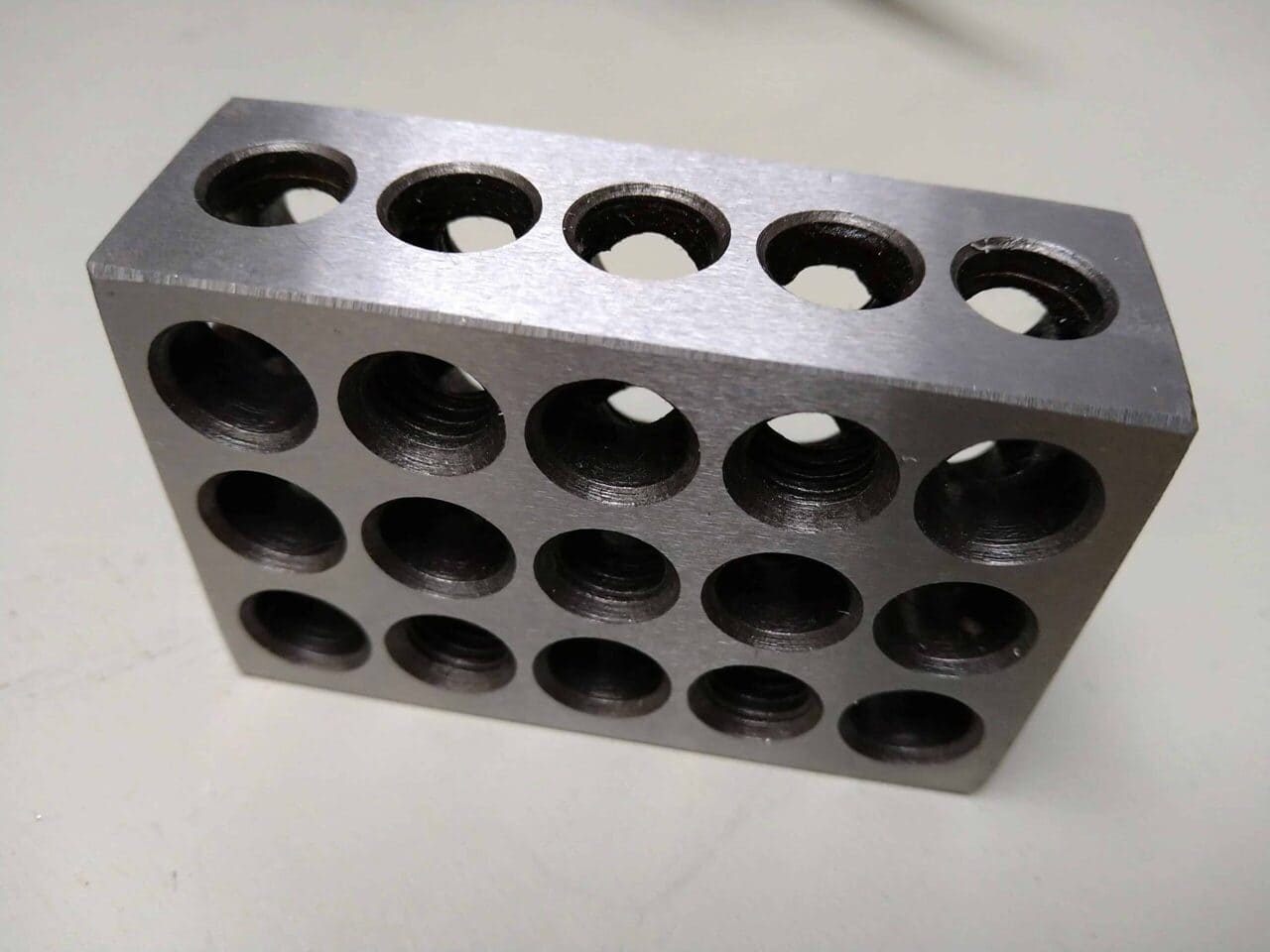1-2-3 blocks are trusted components in many machine shops. But what are they? The name is pretty self-explanatory—1-2-3 blocks are essentially just rectangular metal blocks measuring 1 by 2 by 3 inches.
But what are they for, and why should you care? 1-2-3 blocks are indispensable tools that are cheap, simple, and useful for a wide variety of purposes in machining. This introduction to 1-2-3 blocks will explain what they are, how they are used, and how to machine a set for yourself.
What Are 1-2-3 Blocks, and What Are They Used For?
Simply put, a 1-2-3 block is a rectangular block, usually made of hardened steel, that measures 1 inch thick by 2 inches wide by 3 inches long. Multiple holes are drilled into them on each face, which may be threaded and/or counterbored. Typically, every other hole is threaded, though they can come in countless variations. They are machined to a precise size—typically within 0.0002 inches. The sides are perfectly flat, the faces are perfectly parallel, and the corners are perfectly square.
Machinists use 1-2-3 blocks for various machining and inspection operations, such as:
- Tool touch-off and calibration.
- Elevating the workpiece.
- Checking lengths.
- Gaging right angles.
- Calibrating measuring tools.
The holes can be used to secure the blocks to the table and the workpiece. They are typically used in pairs, but depending on the arrangement of holes, they can be fastened together in any configuration imaginable. Their precision dimensions also make them useful as gauge blocks for quick and easy dimensional checks.
Should You Buy 1-2-3 Blocks or Make Your Own?
While it’s easy to find 1-2-3 blocks for sale, they’re so basic that it’s common for machinists to make their own. Making a 1-2-3 block is often a new machinist’s first assignment in trade school or apprenticeship because it’s fairly simple to make, but it requires attention to precision. Making your first 1-2-3 blocks is a good way to practice cutting, measuring, drilling, and surface finishing.
Furthermore, when you can buy 1-2-3 blocks, you’re stuck with the hole patterns the manufacturer designed. Making your own blocks allows you to customize them to your needs. You can add as many holes as you like, in whatever sizes and patterns you want. You can make them threaded, counterbored/sunk, or any combination thereof. If 1-2-3 blocks are too small for your purposes, you can even make 2-4-6 blocks or any other size you need.
Tips for Making 1-2-3 Blocks
The process of fabricating 1-2-3 blocks consists of four basic steps:
- Machine the blocks oversized.
- Drill and tap the holes.
- Heat treatment.
- Grinding to final dimensions (usually within .0002”).
Of course, it’s not quite as simple as that. Machining your own 1-2-3 blocks requires great attention to precision and accuracy. To be useful, they must be precisely squared and parallel.
Here are some additional tips to keep in mind when fabricating your own 1-2-3 blocks:
- It’s essential to harden the blocks by heat treating them to ensure their durability and rigidity.
- Consider adding countersinks or counterbores to holes so fasteners do not protrude when in use.
- Another option is to add captive fasteners that allow the user to connect one threaded hole directly to another.
Materials for 1-2-3 Blocks from Your Local Metal Supplier
If you want to try making your own 1-2-3 blocks, it’s important to start with high-quality material. At Industrial Metal Service, we sell new steel from the mill as well as verified remnants. We’re confident you can find exactly what you need at an affordable price in our warehouse. In addition to our massive inventory of steel and other metals, we provide precision metal sawing services to cut material to the dimensions you need, saving you time and money.
 Angle
Angle Cast Plate
Cast Plate Diamond Plate
Diamond Plate Flat Bar
Flat Bar Plate
Plate Round Bar
Round Bar Square Bar
Square Bar Square Tubing
Square Tubing Round Tubing
Round Tubing Angle
Angle Channel
Channel Diamond Plate
Diamond Plate I Beam
I Beam Round Bar
Round Bar Sheet
Sheet Square tubing
Square tubing Round Tubing
Round Tubing Rectangular Tubing
Rectangular Tubing Plate
Plate Rectangular Bar
Rectangular Bar Rectangular Tubing
Rectangular Tubing Round Bar
Round Bar Sheet
Sheet Square Bar
Square Bar Square Tubing
Square Tubing
